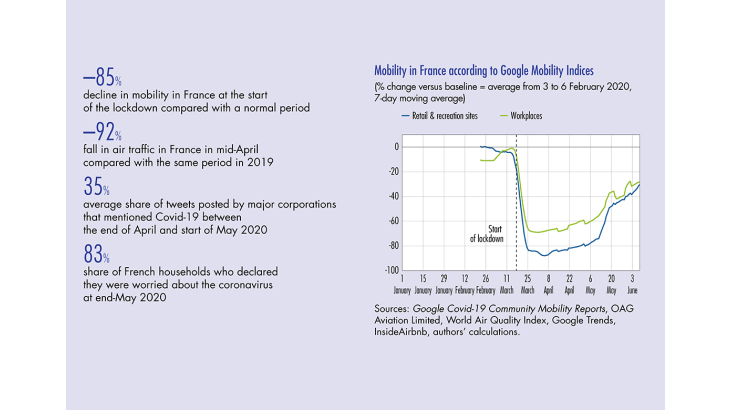Due to its brutality, suddenness and multifaceted nature, the Covid-19 crisis has triggered unprecedented shifts in economic activity and household behaviour. To analyse these trends rapidly, institutions such as the Banque de France have made use of high-frequency data – in other words data published on a weekly or daily basis. This has allowed them to get around the problem of the long publication times for official data, and rapidly measure the impact of the economic shock. It has also helped to provide real-time insight into households’ anxieties, behavior and expectations, and to identify their main concerns, alongside those of the business community. The Banque de France has thus been able to adapt its responses as a public service provider to the expectations of households and businesses – be this in its assistance of overindebted households or in its provision of credit mediation to businesses. This article presents a selection of the indicators used, focusing in particular on household behaviour and on the tracking of the global economy.
1 Covid-19: a growing source of concern for internet users
The coronavirus is a major topic of discussion on the internet
Given the far-reaching and unexpected nature of the health crisis, monitoring how much attention internet users pay to the virus provides crucial information on anxiety and confidence levels among households, and hence on their economic behaviour, and especially their consumption.
The history of global Google searches for the keyword coronavirus and derivatives such as Covid and Covid-19, shows a clear spike in volumes in China from the end of January 2020, then in South Korea and Italy from the end of February, and in other countries from the middle of March. Initially, the lack of knowledge about the virus led to a significant amount of learning behavior on the part of households. Interest then plateaued at the end of March and throughout the first week of April, before gradually declining thereafter (see Chart 1). It should be noted that levels in individual countries are not comparable (see box).
An analysis of the content of Twitter messages (tweets) posted in France provides a more refined view of internet users’ perception of the period from 18 March to 10 May. The evolution of the number of tweets mentioning coronavirus shows clear spikes on 20, 25 and 30 March, all of which follow dates of major announcements linked to the lockdown (respectively its introduction, tightening and extension).
[to read more please download the article]
